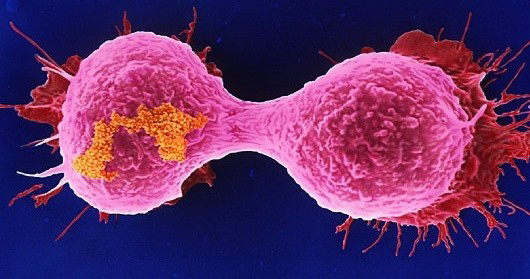
Most cases may be the result of biological bad luck, rather than caused by genes or behavior, with the random division of stem cells making people more vulnerable to mutations, a groundbreaking new study shows.
A formula that plotted the number of stem-cell divisions over a lifetime against the risk of cancer showed a correlation and explained two-thirds of cases, according to a research paper published this week in the journal Science. The study, conducted by mathematician Cristian Tomasetti and geneticist Bert Vogelstein of Johns Hopkins University, is based on previously published cancer statistics.
“All cancers are caused by a combination of bad luck, the environment and heredity, and we’ve created a model that may help quantify how much of these three factors contribute to cancer development,” said Dr. Vogelstein, the Clayton Professor of Oncology at the Johns Hopkins University School of Medicine, co-director of the Ludwig Center at Johns Hopkins and an investigator at the Howard Hughes Medical Institute.
“This study shows that you can add to your risk of getting cancers by smoking or other poor lifestyle factors. However, many forms of cancer are due largely to the bad luck of acquiring a mutation in a cancer driver gene regardless of lifestyle and heredity factors,” he added.
Scientists have known for more than a century that some tissue types give rise to cancer millions of times more often than others, but the reason has not been clear. The new study suggests that the answer chiefly lies in the number of times a tissue’s stem cells divide and replicate their DNA.
“Think of cancer as the risk of having an accident if you are driving a car,” Tomasetti told Time magazine. “If you drive the car on a cross country trip, your risk of an accident is much higher than if you take a local trip to the grocery store. The risk correlates to the length of the trip. The trip to the grocery store might be thought of as bone cancer, which has few stem cell divisions. While the cross country trip might be more like colon cancer, which has many more cell divisions.”
The findings may bolster arguments that some types of cancer often can’t be prevented, with risky behavior such as smoking and excessive exposure to the sun being less of a cause than chance. That would support focusing more efforts on diagnosing the disease in early stages and on treatments to reduce mortality rates, the researchers say.
However, they cautioned that the study isn’t a license to engage in unhealthy behavior. “Cancer-free longevity in people exposed to cancer-causing agents, such as tobacco, is often attributed to their ’good genes,’” said Vogelstein, “but the truth is that most of them simply had good luck.”
Furthermore, some forms of cancer are exceptions, where lifestyle and environment play a big role. Lung cancer is one of them. So is skin cancer. And, if cancer runs in your family, this unfortunately doesn’t mean you’re in the clear. Some cancers are more strongly influenced by genetic heritage than others.
“Bad luck” mutations
The researchers focused on stem cells because they live longer, with divisions of the self-renewing cells maintaining the tissue’s stability while also having the capacity to initiate a tumor. Random mutations — or bad luck — occurring during the replication of noncancerous stem cells, which typically account for a small number of the total cells in tissue, can lead to the disease.
The lifetime risk of being diagnosed with lung cancer is 6.9 percent, while that of thyroid is 1.08 percent and brain cancer is 0.6 percent, according to published statistics. Acknowledged risk factors that explain some of the incidence include smoking, alcohol consumption, ultra-violet light and human papilloma virus, as well as genetic variations.
To explain the remaining cancer risk, the researchers from Baltimore, Maryland-based Johns Hopkins focused on 31 tissue types. “Bad luck” mutations – which occur when one chemical letter in DNA is wrongly swapped for another during cell replication – largely explained 22 of the 31 cancer types studied. The remaining nine had incidence rates higher than predicted by bad luck, presumably due to the influence of environmental or inherited factors.

“We found that the types of cancer that had higher risk than predicted by the number of stem cell divisions were precisely the ones you’d expect, including lung cancer, which is linked to smoking; skin cancer, linked to sun exposure; and forms of cancers associated with hereditary syndromes,” Vogelstein said.
Some cancers, including breast and prostate, weren’t included in the report because reliable stem-cell division rates haven’t been determined, according to the study.
Four in 10 cancers still preventable with lifestyle changes
The scientists suggest that since many types of cancer cannot be prevented through behavioral changes or genetic screening, more efforts should be made to hasten diagnosis.
“If two-thirds of cancer incidence across tissues is explained by random DNA mutations that occur when stem cells divide, then changing our lifestyle and habits will be a huge help in preventing certain cancers, but this may not be as effective for a variety of other,” said Tomasetti. “We should focus more resources on finding ways to detect such cancers at early, curable stages.”
However, health experts point out that lifestyle changes can still have a huge impact on cancer risk. “While some genetic mistakes are due to bad luck, we know that our cancer risk depends on a combination of our genes, our environment and other aspects of our lives, many of which we can control,” Dr. Emma Smith, senior science information officer at Cancer Research UK, told The Telegraph.
“We estimate that more than four in 10 cancers could be prevented by lifestyle changes, like not smoking, keeping a healthy weight, eating a healthy diet and cutting back on alcohol,” she added.
